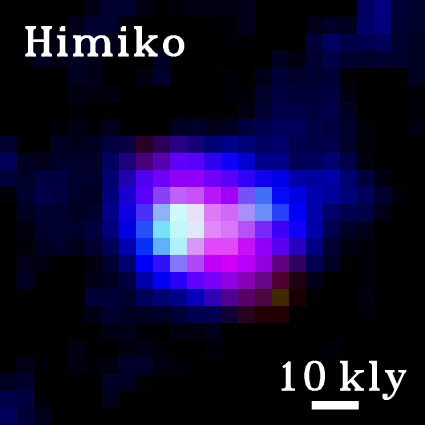Astronomers using a suite of telescopes including the W. M. Keck Observatory have discovered a giant gas object that may be one of the earliest ancestors of a forming galaxy. This object, dubbed an extended Lyman-Alpha blob and identified as Himiko, sits nearly 13 billion light years from Earth and spans 55 thousand light years, a record for that early point in time.
“Measuring the distance to this object with Keck’s instrumentation was fundamental to making this discovery,” says Taft Armandroff, director of the Keck Observatory. “The observations show that this gigantic gaseous object formed when the Universe was only about 800 million years old, a time when astronomers have not expected to see objects like these.”
In fact, astronomer Masami Ouchi, a fellow at the Observatories of the Carnegie Institution, was not sure of what he and his colleagues were observing when they first spotted Himiko. Even with data from the world’s best telescopes, the Lyman-Alpha blob is one of the most distant objects ever found. Its distance does not easily allow researchers to understand its physical origins. The object could therefore be ionized gas powered by a super-massive black hole, a primordial galaxy with large gas accretion, a collision of two large young galaxies, super wind from intensive star formation or a single giant galaxy with a large mass of about 40 billion Suns, says Ouchi, who led the astronomers from the U.S., Japan and the United Kingdom in discovering Himiko.
“I never imagined that such a large object could exist at this early stage of the Universe’s history,” Ouchi says. “I am surprised by this discovery because according to Big Bang cosmology, small objects form first and then merge to produce larger systems.” This object spans 55 thousand light years, which roughly compares to the radius of the Milky Way. Yet, it exists at a time when the age of the Universe was only six percent of the age of today’s Universe, Ouchi explains.
He and his colleagues first discovered Himiko in the constellation Cetus using the Subaru telescope. The object was among 207 distant galaxy candidates. But it seemed extraordinarily large and bright to be far away. The team, therefore, hesitated to spend their “precious telescope time” taking spectra of this “weird candidate” because the object might be a foreground interloper contaminating the galaxy sample, Ouchi says. The astronomers decided to take the spectra anyway using the Keck II telescope and its DEep Imaging Multi-Object Spectrograph and also Carnegie’s Magellan/IMACS instrumentation and were then able to measure the distance to Himiko.
Most of the extended Lyman-Alpha blobs discovered so far sit at distances when the Universe was two to three billion years old. But, the data show Himiko is located at the re-ionization epoch, which occurred between about 200 million and one billion years after the Big Bang and which is one of the earliest observable points in the history of the Universe. To better understand the re-ionization epoch, astronomers search for characteristic hydrogen signatures released when the region’s ionized gas clouds scatter light in a specific way. Theoretical studies suggest that the first stars and galaxies formed from neutral hydrogen atoms and that these objects subsequently emitted ultraviolet photons re-ionizing the Universe.
Himiko’s spectra clearly exhibited the re-ionization epoch characteristic hydrogen signature indicating that the object was actually at a distance of 12.9 billion light years, Ouchi says. The research appears in the May 10 issue of The Astrophysical Journal.
Data taken with NASA’s infrared Spitzer Space Telescope, the United Kingdom Infrared Telescope, radio data from the Very Large Array and X-ray imaging from the XMM-Newton satellite allowed astronomers to estimate Himiko’s visible mass and its star formation rate. The astronomers have also begun investigating whether the object contains a central, active super-massive black hole at its core.
Himiko’s existence is puzzling, however, because if it marks a new class of objects that are ancestors of today’s galaxies, astronomers should have already found smaller ones in distant regions, says team member Alan Dressler also of Carnegie. But this object is currently one-of-a-kind. Its discovery therefore makes it hard to fit the object into the prevailing model of how normal galaxies were assembled.
The team’s research was funded by the NASA through an award issued by JPL/Caltech, the Department of Energy, and the Carnegie Institution. The result is based in part on data collected at the W.M. Keck Observatory, which is operated as a scientific partnership among the California Institute of Technology, the University of California, and NASA; Subaru Telescope, which is operated by the National Astronomical Observatory of Japan; the Spitzer Telescope, managed by JPL for NASA; the Magellan telescopes operated by a consortium consisting of the Carnegie Institution, Harvard University, MIT, the University of Michigan, and the University of Arizona; and the United Kingdom Infrared Telescope, which is operated by the Joint Astronomy Centre on behalf of the Science and Technology Facilities Council of the UK.


